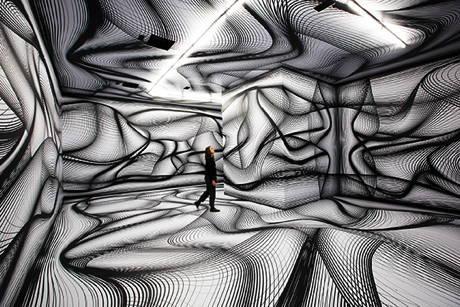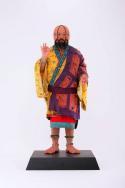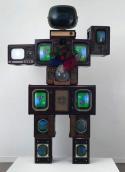Art Of The Day Weekly
#509 - from 5 April 2018 to 11 April 2018

Peter Kogler, Untitled, 2018, digital print on vinyl, variable dimensions © Photo Aldo Paredes pour la Rmn-Grand Palais, 2018 (exhibition Artistes & Robots, Grand Palais)
IN THE AIR
Artists of the past or of the future, forgotten or virtual
With all that is going on around us, we can only wish - more than ever-, to run all the exhibitions without missing a single one. But we could also step back a little, consider the exhibitions and artists in their totality, and try to classify or even summarize. With the number of retrospectives coinciding in this beginning of April in Paris, the cruelest month of the year according to T.S. Eliot, we have the perfect opportunity to think about the status of the artist. How far must he/she intervene manually to be the “creator”? This is not a very new debate. While in the period of the Renaissance, painters had no software, nor 3-D copying machines, they did have helpers in their workshops who carefully finished off certain details for them. But we now face new challenges with the possibility we have of reproducing art works indefinitely, of dematerialization, of using machines that “think”. Could we claim Monet and robots have the same fate?
EXHIBITIONS
The time of robots
PARIS – Man has always wanted to create machines in his image, which he could manipulate. The golem, in Rudolf’s esoteric Prague, is but one example among others, next to Frankenstein or the creature of Metropolis. Today, in Japan, very proper robots sip tea wit old ladies. Artists of the 21st century have nothing to be jealous of, as they use tools that are increasingly perfected technologically, and leave the material tasks for others. The Grand Palais looks into this matter from all sides: there is a huge difference between the submissive robot created by Tinguely or Schöffer; the invisible robot, often an algorithm, as with Elias Crespin or Miguel Chevalier; and last but not least the robot who takes over, as with Orlan or Nicolas Darrot. If robots revolt in the future, will they become the only author?
• Artistes & robots at the Grand Palais, from 5 April to 9 July.
EXHIBITIONS

Takashi Murakam, Untitled, 2016, silicon, FRP, animatronics H. 187 x L. 90,5 x l. 91 cm © 2016 Takashi Murakami / Kaikai Kiki Co., Ltd. All Rights Reserved. Courtesy Perrotin
The time of robots
PARIS – Man has always wanted to create machines in his image, which he could manipulate. The golem, in Rudolf’s esoteric Prague, is but one example among others, next to Frankenstein or the creature of Metropolis. Today, in Japan, very proper robots sip tea wit old ladies. Artists of the 21st century have nothing to be jealous of, as they use tools that are increasingly perfected technologically, and leave the material tasks for others. The Grand Palais looks into this matter from all sides: there is a huge difference between the submissive robot created by Tinguely or Schöffer; the invisible robot, often an algorithm, as with Elias Crespin or Miguel Chevalier; and last but not least the robot who takes over, as with Orlan or Nicolas Darrot. If robots revolt in the future, will they become the only author?
• Artistes & robots at the Grand Palais, from 5 April to 9 July.
Artists, from A to Y
PARIS – Following two record-breaking exhibitions – the Shchukin collection, and then the MoMA, with 1.2 million visitors and nearly 800 000 respectively - the Fondation Louis is delving into a much more difficult subject, with a poetic title. It aims at presenting a series of artists from its own collection. The difficulty lies in finding some sort of unity in something that does not necessarily have any, from Giovanni Anselmo, an actor of Arte Povera, to Korean artist Anicka Yi. This is the place of man in the universe, his competition with the animal and the vegetable worlds, questioned with Murakami, Giacometti or Pierre Huyghe who once again plays the huge explosion of species from the Cambrian period in an aquarium.
• Au diapason du monde at Fondation Louis Vuitton, from 11 April to 27 August 2018.
The Baltic, an unknown territory
Here we have a concrete example of artists from nearby countries – the three Baltic countries, briefly independent after the First World War, then under the domination of the Soviet Union until 1991 when they recovered their autonomy – about whom we know nothing. Aside from Ciurlionis, whose charming house in Vilnius is worth a detour, and who has been seen a number of times in retrospectives on Symbolism, I am not sure we could give the name of an artist, and not only due to the spelling of their picturesque names. Triik? Purvitis? Magi? Zmuidzinavicus? Ruscicas? These 130 works seldom shown outside of Lithuania, Estonia, and Latvia offer us a true symphony of Nature (the forest), of the seasons (winter), as well as portraits full of color. The borders of Europe have the charm of all that is new.
• Ames sauvages. Le symbolisme dans les pays baltes at the musée d’Orsay, from 10 April to 15 July 2018. Catalogue Musée d’Orsay/RMN.
OPENINGS OF THE WEEK

ERIC RONDEPIERRE
7 April 2018 - PARIS - Galerie Isabelle Gounod
Film shots that look like paintings
BOOKS
Big-hearted women
We could have spoken about them on March 8,since they are remarkable women. But we shouldn’t limit them to one category, since made art advance in general, regardless of their sex, and pushed abstraction as far as possible, or renewed the use of thread and yarn. These eleven creators showed character, audacity, freedom, and were cosmopolitan in design (Vera Molnar), painting (Geneviève Asse), textile (Sheila Hicks), or sculpture (Marta Pan). Many of them came from far, in particular from Hungary. We have one remark to make, regarding the print, which is very small, and we regret the lack of clear biographical notes. While these women all had long lives, as many are over 90 years old (Geneviève Asse is 95), some of them have already left us, such as Shirley Jaffe in 2016 or Aurélie Nemours in 2005. As the texts – clearly very interesting – are all written in the present and are rather discrete on the last few years, it is difficult to know who is still alive – even though they would all deserve to be. An exhibition has been organized on these eleven pioneers until 7 April at the galerie Pierre-Alain Challier (rue Debelleyme, in Paris).
• Les Pionnières, dans les ateliers de femmes artistes du XXe siècle, texts by Elisabeth Védrenne and Valérie de Maulmin, photos by Catherine Panchout, Somogy, 2018, 200p., €39.
IN BRIEF
PARIS - The Art Paris Art Fair is being held from 4 to 8 April 2018.
PARIS - The PAD Art Fair is being held from 5 to 8 April 2018.



